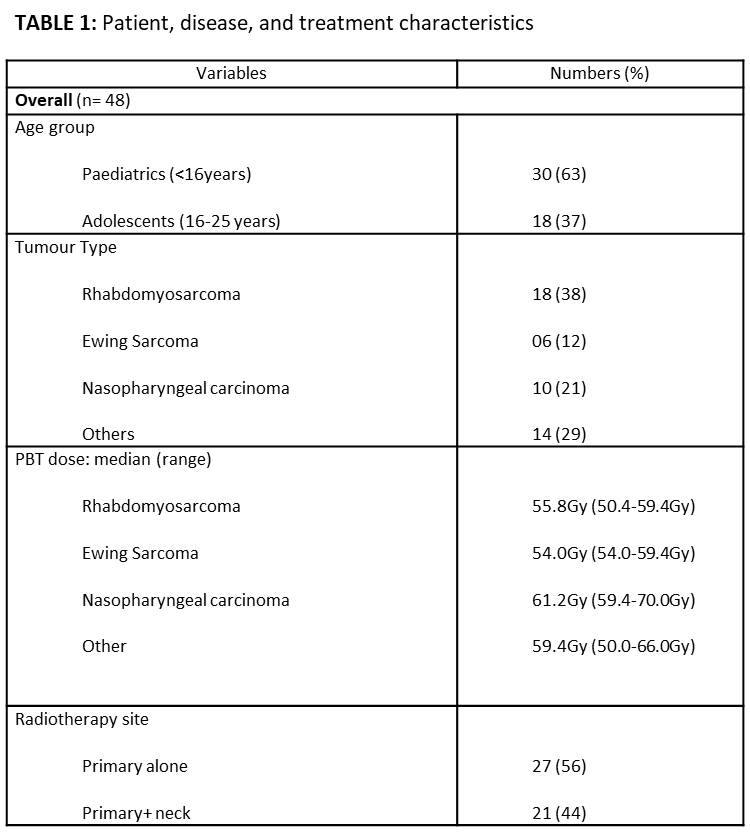Factors predicting a replan in children treated with proton therapy for tumours of the head and neck
Avinash Pilar,
United Kingdom
OC-0758
Abstract
Factors predicting a replan in children treated with proton therapy for tumours of the head and neck
Authors: Avinash Pilar1, Daniel Saunders1, Shermaine Pan1, Simona Gaito1, Frances Charlwood2, Matthew Lowe2, Ed Smith1, Andrew Mcpartlin1, Nicola Thorp1
1The Christie NHS foundation Trust, Clinical Oncology, MANCHESTER, United Kingdom; 2The Christie NHS foundation Trust, Radiotherapy Physics, MANCHESTER, United Kingdom
Show Affiliations
Hide Affiliations
Purpose or Objective
Effective delivery of Proton beam
therapy is predicated on precise planning and allowance for dynamic anatomical
changes on treatment. Despite this daily online cone-beam CT (CBCT) imaging is only routinely
available in a minority of proton centres. The impact of daily CBCT imaging on
replan rates is poorly reported. We report replanning rates and factors that
necessitated a replan in paediatric/adolescent patients treated with PBT and
daily CBCT.
Material and Methods
We retrospectively analysed
prospectively maintained electronic records for all patients <25 years of
age treated with PBT at our institute for HN malignancies between 2018-2020. All
patients were treated with pencil beam scanning PBT and daily IGRT with a CBCT.
A dosimetric review was performed when significant anatomical changes were
noted on the CBCT. If the dosimetric review showed a significant difference
compared to the original plan a replan was done at the clinician’s discretion.
Results
48 patients <25 years of age were
treated with PBT at our institute for HN malignancies during the study period. The median age at treatment was 14 years
(range: 1-25 years). The most common tumour type was Rhabdomyosarcoma (RMS)
[38%] followed by nasopharyngeal carcinoma (NPC) [21%] and Ewing sarcoma (ES)
[12%]. The neck was electively treated in all patients with NPC (n=10) and only in the
case of N1 disease in other tumour types (n=11). The median dose to the primary was
55.8Gy (Range: 50.4-70Gy). The patient, disease, and treatment characteristics are highlighted in table 1.
About 1/3rd of the patients (n=14, 29%) required a replan during their
PBT and one patient required replanning twice. The majority
(60%) of the replans were required during week 3 and beyond, and 27% (n=4) of
the replans were done even before the start of the PBT based on changes seen on
Day 1 CBCT. The
reasons for replanning included external contour increase (n=6), contour
decrease (n=4), sinus filling (n=2), changes in GTV (n=2), setup mismatch (n=3),
and discrepancy in the position of LMA (n=1) as seen on the CBCT. Replanning
rates correlated with the tumour type (NPC vs others p=0.001) and treatment to
the neck (p=0.002) but did not correlate with a weight change (<5% vs >5%
change, p=0.40) and prophylactic feeding tube (Yes vs No p=0.71). External
contour change during PBT did not significantly correlate with a weight change
(p=0.41) or prophylactic feeding tube (p=0.31) either.
Conclusion
Approximately a third of the patients
required replanning and in the majority, it was prompted by an external contour
change. The replanning rates were associated with tumour type and treatment to
the neck but were not associated with changes in weight or placement of a
prophylactic feeding tube during PBT. This finding highlights the value of CBCT
imaging with proton therapy to identify tissue changes significantly affecting
dosimetry, which may not be appreciable clinically.
